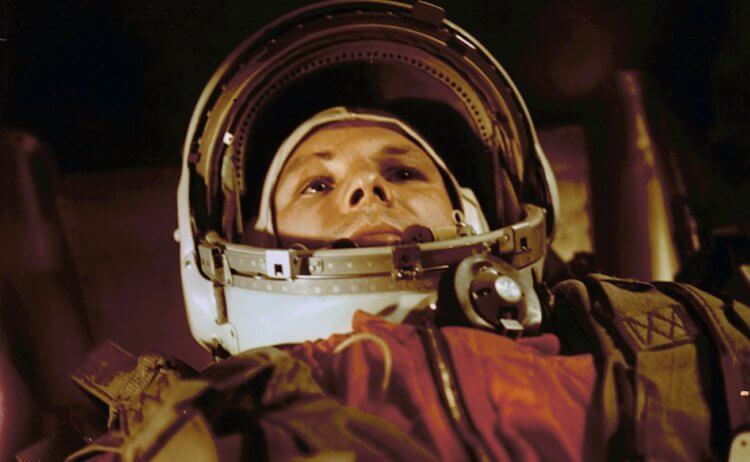Every healthy person can live without food for about one month. However, at the same time, he will be very weak physically, and will also not be able to think well – food is very important for the production of energy and the functioning of all internal organs. It is especially important to maintain strength and sanity in space, so astronaut dietand astronauts are trying to diversify as much as possible. Today, Russian cosmonauts can easily have breakfast with rice porridge with dried apricots and cottage cheese with nuts, and in the evening have pork with lecho for dinner. But in Soviet times, everything was much more complicated, because scientists were initially not sure that people could eat anything at all in space: what if digestion completely stops in zero gravity? So what was given to Yuri Gagarin during his legendary flight so that he could test whether it was possible to eat food in space?

Valentina Tereshkova eats in space through a tube. Photo source: kp.ru
Contents
- 1 The first man in space
- 2 Why cosmonauts ate food from a tube
- 3 What did Yuri Gagarin eat in space
- 4 How does digestion work in space
- 5 What do astronauts eat on the ISS today
The first man in space
The first manned flight into space took place on April 12, 1961—every person on Earth should know about this. On this day, Soviet cosmonaut Yuri Gagarin boarded the Vostok-1 spacecraft and made one orbit around our planet. Almost the entire flight took place in automatic mode, because the ship was controlled from Earth. Yuri Gagarin's main task was to monitor the progress of the mission and report on his well-being.

Yuri Gagarin before his flight into space. Photo source: roscosmos.ru
Read also: 7 little-known facts about the feat of Yuri Gagarin
Why did the astronauts eat food from a tube
The astronaut spent 108 minutes in space, that is, a little more than an hour and a half. However, the management provided him with a supply of food for two weeks, because during the first and very risky flight anything could happen. For example, Gagarin could lose contact with the Earth, and he would have to wait for the spacecraft to naturally enter the Earth's orbit, which could take a long time. And then he would have to hope that the landing would be soft.
Despite the fact that before the flight, scientists conducted many experiments, they did not know how the digestive system would behave in conditions unnatural for humans. For example, they had no idea whether Yuri Gagarin would be able to chew food, swallow it, and so on. Therefore, the researchers tried to make his diet as easy as possible – they crushed the food and placed it inside tubes like toothpastes.

Tubes of food for cosmonauts during the USSR. Photo source: gazeta.ru
In addition to making it easier to chew and digest food, scientists wanted to make sure that food crumbs did not fly off. They understood that any solid or small particle inside Vostok-1 could get into the electronics and cause the world's loudest tragedy. Tubes with liquid and nutrient mass turned out to be an ideal option for use in space. They easily satisfied hunger, were quickly absorbed by the body and were safe for electronic equipment.
Everyone should know this: Not only Yuri Gagarin: domestic cosmonauts who have accomplished feats in space
What did Yuri Gagarin eat in space
In just over an hour and a half of being outside our planet, Yuri Gagarin managed to try two dishes. First, he squeezed out a nutritiousbeef and liver puree from a tubeIt is possible that it was tasty, because the great cosmonaut later tasted the second tube. A few minutes later, the first person in space tried chocolate sauce, which was also placed inside the tube.

A tube of borscht for astronauts. Photo source: theatlantic.com
The man who fell from space:the story of Vladimir Komarov's failed stunt
How digestion works in space
Having tasted meat puree and dessert, Yuri Gagarin proved that human digestion is possible in space works the same as usual. While on space travel, people can eat canned food and try different drinks (except alcohol!) without fear that they will become ill.

Modern astronaut food. Photo source: Roscosmos
During subsequent flights into space, people only noticed that in zero-gravity conditions they tasted food worse. It turns out that in space, fluids inside the body shift to the head, which leads to a weakening of taste buds. When people eat in space, it's a bit like eating when you have a cold—the food tastes bland.
You might be interested:What does it smell like in space – the astronauts gave a detailed answer
What do astronauts eat on the ISS today
Today, cosmonauts and astronauts can afford much more than in the mid-20th century. They can eat canned food and many other foods – the NASA website even has a list of food that astronauts can order, and it is very large. One day, pizza was even sent to the International Space Station, and the station crew was able to bake delicious cookies.

Astronauts eat pizza on the ISS. Photo: CGTN
Have you already subscribed to our Zen channel? If not, now is the time to fix it because comments are open!
Before sending people into space, researchers conducted experiments with animals. The most famous of them, of course, are the dogs Belka and Strelka. Perhaps the story of animals in space is not over yet, because China wants to send monkeys into space in the future.